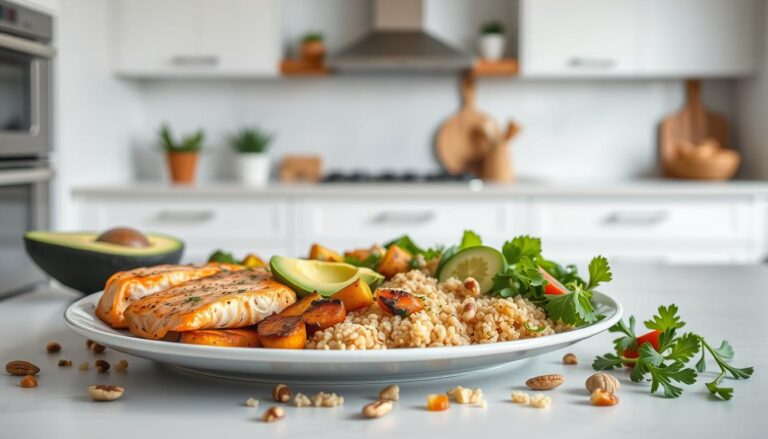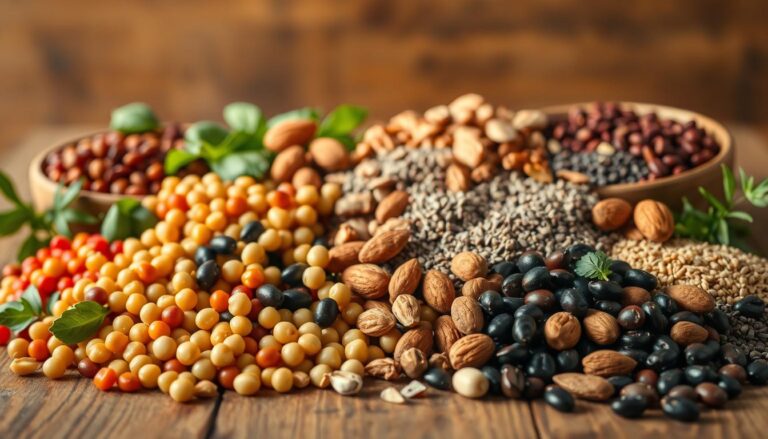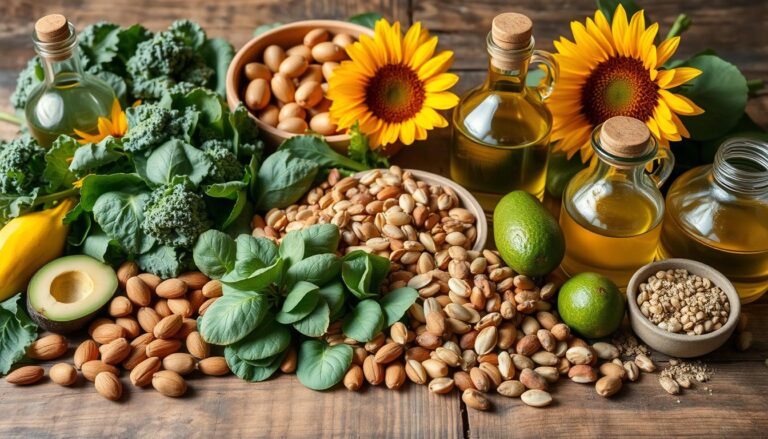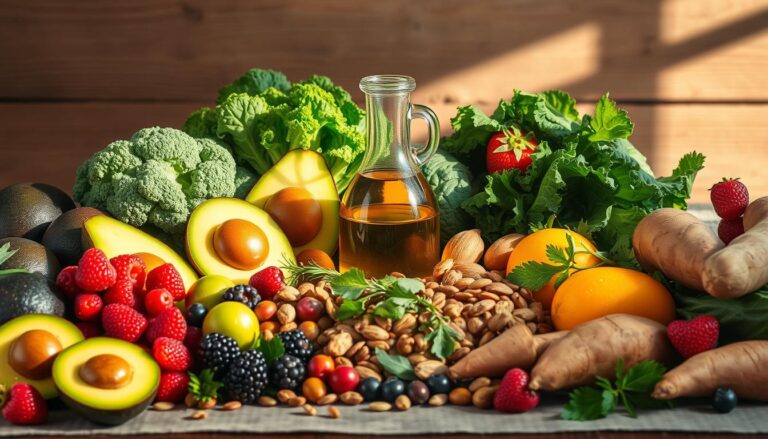The answer traces back to rigorous science and simple meals. A collaborative team led by Dr. George Bray Dr. Donna Ryan and Dr. Catherine Champagne published landmark results in the New England Journal of Medicine in 1997.
The work was funded by the National Heart, Lung and Blood Institute to build a practical approach that would lower blood pressure and cut disease risk.
The program centers on fruits, vegetables, whole grains, lean proteins and low‑fat dairy, with smart sodium targets about 1,500–2,300 mg/day . It delivers quick wins for blood pressure and longer-term gains in weight loss and lipid control.
Why trust it? U.S. News ranks this method among the best overall. The American Heart Association gives it top marks as a heart‑healthy approach. Later sections show how to use these evidence-based swaps at home and when dining out.
Key Takeaways
- Built on landmark clinical trials led by well known researchers.
- Focuses on whole foods and sodium limits to lower blood pressure fast.
- Backed by the National Heart Lung, and Blood Institute and top rankings.
- Offers practical, family friendly swaps for everyday meals.
- Delivers heart and metabolic benefits plus support for weight goals.
Why the DASH Diet Leads for Heart and Metabolic Health in the United States
A strong evidence base and consistent rankings explain why this eating plan leads national guidance on cardiovascular care. The original trials were funded by the National Heart Lung, and Blood Institute and tested real foods not supplements or commercial products.

Evidence at a glance
The plan, officially the Dietary Approaches to Stop Hypertension earned top marks in repeated evaluations from U.S. News & World Report. Expert scoring by the American Heart Association and other panels also ranks it high among heart-healthy patterns.
What it is and what it is not
This eating plan aims primarily to lower blood pressure and cut cardiovascular disease risk through nutrient dense choices. Many people see weight loss as a side benefit but the core goal is pressure control using potassium calcium and magnesium rich foods combined with sensible sodium limits.
- No special products: It relies on regular supermarket foods and practical portions.
- Proven effect: Trials showed meaningful blood pressure reductions and lower long-term risk when paired with healthy habits.
DASH Diet Remains 1 for Heart and Metabolic Health The Proven Benefits
Clinical trials show quick measurable gains when people adopt a balanced, mineral-rich eating pattern and cut excess sodium. Small changes can bring big wins in weeks.

Lower sodium lower pressure
Standard guidance targets about 2,300 mg sodium per day. A lower cap near 1,500 mg delivers larger drops in blood pressure and less variability.
Cardiovascular wins
Trials linked these changes to notable outcomes: roughly a 27% lower stroke rate and 15% lower heart disease in related analyses. Improvements in cholesterol add another layer of protection.
Metabolic and practical gains
Following this eating pattern can support weight loss when calories are controlled and may improve markers tied to diabetes and metabolic syndrome.
- Why it works: more potassium, calcium, magnesium fewer processed foods.
- Who gains most: people with high blood pressure or elevated cardiometabolic risk.
Core Eating Pattern Foods to Emphasize and Limit for Lower Blood Pressure
Simple swaps on your plate can boost potassium, calcium, magnesium, and fiber while cutting excess sodium. Focus on whole, minimally processed choices that give nutrients without added salt.

Build your plate
Half the plate should be vegetables and fruits. One quarter is whole grains one quarter is lean protein. Add 2–3 servings of low-fat dairy across the day.
Power nutrients
Prioritize foods rich in potassium, calcium, magnesium, and fiber. Good picks include leafy greens beans nuts, low-fat dairy, and whole grains. These nutrients help support healthy blood pressure and overall heart function.
What to limit
Cut back on processed meats, sweets, sugary drinks, full fat dairy, and solid fats. Keep sodium near 2,300 mg daily or aim lower at 1,500 mg for added benefit.
Servings guide 2,000 kcal
- Vegetables: 4–5 servings/day
- Fruits: 4–5 servings/day
- Grains: 6–8 servings ≥3 whole
- Low-fat dairy: 2–3 servings
- Lean meats/fish/poultry: up to 2/day beans, nuts 4–5/week
Translate servings: 1 cup yogurt or milk, 1/2 cup cooked grains, 1 oz cooked lean meat, 1/3 cup nuts. Scale portions up for higher activity and down to lose weight. Rotate fish, beans, and lentils to balance protein with fiber.
Pantry audit checklist: extra virgin olive oil, low-sodium broth, canned beans whole grain bread, unsalted nuts, low-fat dairy, and spice blends without salt.
How to Start DASH Today Step by Step Implementation
Start small and build habits that stick. Begin with a pantry reset, swap salty sauces for herbs and citrus, and plan one meatless meal each week. These moves make healthy eating practical and fast.
Kitchen and pantry swaps
Do a quick audit. Choose low-sodium broth, unsalted nuts, whole grains, and olive oil instead of solid fats.
Tip: Keep an herb rack and spice blends to replace the salt shaker.
Sodium smart shopping and cooking
- Read labels: aim for items under 5% Daily Value sodium.
- Limit processed and frozen entrées cook from scratch when possible.
- Use umami ingredients such as mushrooms, tomatoes, and vinegar to boost flavor.
Portion, movement, and eating out
Keep protein near 6 oz per day and rotate beans, lentils, tofu, or eggs twice weekly. Aim for 150–180 minutes of moderate activity each week to support weight and lower risk of high blood pressure.
When dining out, request no added salt, skip salty condiments, and choose vegetable sides or grilled options.
| Action | At Home | Shopping | Dining Out |
|---|---|---|---|
| Reduce sodium | Cook with herbs, citrus, vinegar | Pick items <5% DV sodium | Ask for no added salt or MSG |
| Protein control | Limit meat to 6 oz/day | Buy beans, tofu, canned fish | Request protein as a side |
| Meal prep | Batch-cook veggies and grains | Choose whole grains, unsalted nuts | Choose steamed or grilled plates |
Practical Planning Sample Day Structure Meal Ideas and Tracking
A practical daily template helps you hit produce, whole grains, and dairy goals without stress. Use this model as a base and adjust portions to match activity and weight goals.
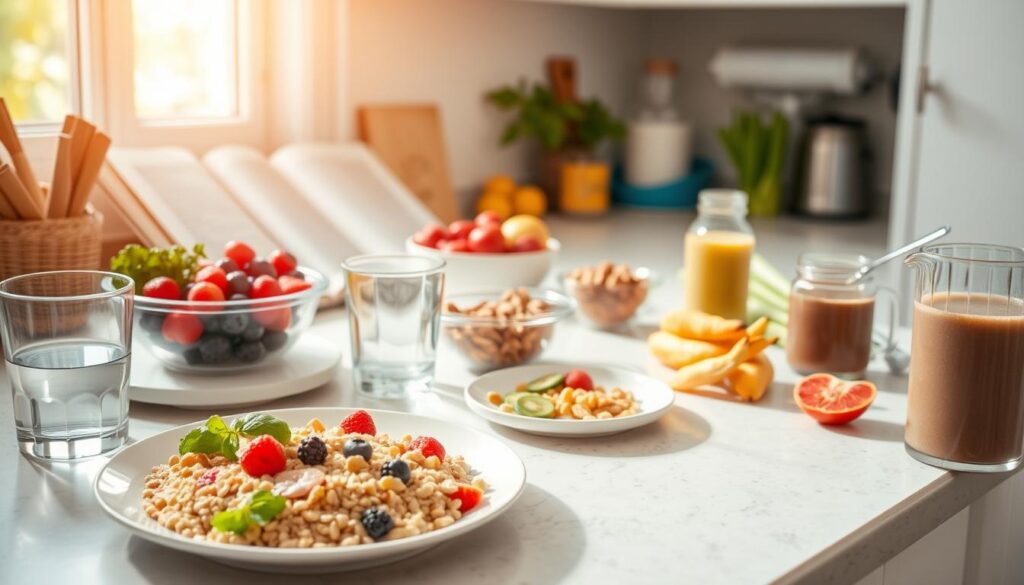
Sample day template
Breakfast: oatmeal with berries and low-fat dairy. Lunch: a veggie packed grain bowl with beans. Dinner: grilled salmon, quinoa, and mixed greens. Snacks: fruit, yogurt, or a small handful of unsalted nuts.
Ideas and a 7 day rotation
Batch-cook whole grains and roast trays of vegetables to save time. Repeat favorite meals across a 7‑day rotation and vary proteins like fish, beans, and poultry.
Portions, swaps, and tracking
Use simple cues: 1 cup milk or yogurt = 1 dairy serving 1/2 cup cooked grains = 1 grain serving 1 oz lean meat = 1 protein serving. Keep sodium near 2,300 mg or lower to help lower blood pressure.
- Mix-and-match foods: leafy greens, beans, nuts, seeds, whole grains.
- Smart dairy swaps: skim milk or low-fat yogurt to boost calcium without extra saturated fat.
- Tracking prompts: log blood pressure and weight weekly review cholesterol with your clinician use apps to monitor sodium and food intake.
| Action | Tip | How it helps |
|---|---|---|
| Batch prep | Cook grains, roast veggies | Saves time, keeps servings steady |
| Rotate proteins | Fish, beans, poultry | Boosts fiber and lean protein |
| Track | BP log, weekly weigh-ins | Monitors risk and progress |
Conclusion
Real-food swaps and steady activity form a simple path to lower pressure and long-term risk reduction.
This evidence backed approach rooted in National Heart Lung, and Blood Institute research and endorsed by the American Heart Association, lowers blood pressure in weeks and improves cholesterol and disease risk over time.
Start now: make one low-sodium swap today, add an extra serving of vegetables, and plan a brisk 20–30 minute walk. Small steps add up across the day and week.
In short, nutrient-rich foods plus sodium awareness and regular activity make a practical plan that supports weight, reduces hypertension risk, and fits grocery-store life. Choose a 7-day rotation, stock whole grains and produce, and log blood readings to track progress.
